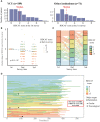Association of high disease activity and serum IL-6 levels with the incidence of inflammatory major organ events in Behçet disease: a prospective registry study
- PMID: 38686380
- PMCID: PMC11057327
- DOI: 10.3389/fimmu.2024.1354969
Association of high disease activity and serum IL-6 levels with the incidence of inflammatory major organ events in Behçet disease: a prospective registry study
Abstract
Background: Little is known about the relationship between the disease activity of Behçet disease (BD) and the incidence of inflammatory major organ events.
Objectives: In this prospective registry study, we investigated the association between the Behçet Disease Current Activity Form (BDCAF) and incidence of inflammatory major organ events, defined as the inflammation of the ocular, central nervous, intestinal, and vascular systems in BD.
Methods: We enrolled participants from Japanese multicenter prospective cohorts. The BDCAF was evaluated annually. BD-related symptoms, including inflammatory major organ events, were monitored. The association between BDCAF and inflammatory major organ events was analyzed by time-to-event analysis. An unsupervised clustering of the participants' BDCAF, therapeutic agents, and multiple serum cytokines was also performed to examine their association with inflammatory major organ events.
Results: A total of 260 patients were included. The patients had a median BDCAF score of 2 [Interquartile range, 1-3] at the enrolment and remained disease active at 1- and 2-year follow-ups, indicating residual disease activity in BD. Patients with a BDCAF score of 0 had a longer inflammatory major organ event-free survival at 52 weeks than those with a score of 1 or higher (p=2.2 x 10-4). Clustering analysis revealed that patients who did not achieve remission despite treatment with tumor necrosis factor inhibitors had high serum inflammatory cytokine levels and incidences of inflammatory major organ events. Among the elevated cytokines, IL-6 was associated with inflammatory major organ events.
Conclusion: This study suggests that treatment strategies targeting overall disease activity and monitoring residual serum IL-6 may help prevent inflammatory major organ events in BD.
Keywords: Behçet disease; cluster analysis; disease activity; disease registry; systemic vasculitis.
Copyright © 2024 Hirahara, Kirino, Soejima, Iizuka, Yoshimi, Fujieda, Atsumi, Tono, Kobayashi, Meguro, Takeuchi, Sakamaki, Takeno, Mizuki and Nakajima.
Conflict of interest statement
YK has received support from Amgen speaking fees, support for attending meetings and travel, and advisory board, Novartis speaking fees and advisory board, and Nippon Shinyaku grants. Mitsuhiro Takeno has received consulting and speaking fees from Amgen; research grants and speaking fees from AbbVie, Asahi Kasei, Chugai, Eisai, Tanabe-Mitsubishi, and Taisyo; and speaking fees from Astellas, Asympti, Boehringer-Ingelheim, Eli Lily, Jansen Pharma, Nippon Shinyaku, Novartis, Ono Pharmaceuticals, Takeda, UBC Japan, and Viatris. Tatsuya Atsumi has received grants from Chugai Pharmaceutical Co., Ltd., Daiichi Sankyo Co. Ltd., Nippon Boehringer Ingelheim Co., Ltd., TEIJIN PHARMA LIMITED., Eisai Co., Ltd., and Eli Lilly Japan K.K. Tetsuya Atsumi has also received consulting fees from Sanofi K.K, GlaxoSmithKline plc, AbbVie Inc., AstraZeneca plc, Chugai Pharmaceutical Co., Ltd., Nippon Boehringer Ingelheim Co., Ltd., Janssen Pharmaceutical K.K., Gilead Sciences, Inc., Eli Lilly Japan K.K., and ONO PHARMACEUTICAL CO., LTD. TA has also received payment or honoraria for lectures, presentations, speakers’ bureaus, manuscript writing, or educational events from Takeda Pharmaceutical Co., Ltd., Astellas Pharma Inc., Mitsubishi Tanabe Pharma Co., Chugai Pharmaceutical Co., Ltd., Daiichi Sankyo Co. Ltd., Pfizer Inc., Alexion Inc., Novartis Pharma K.K., Eli Lilly Japan K.K., Kyowa Kirin Co., Ltd., AbbVie Inc., Nippon Boehringer Ingelheim Co., Ltd., Amgen Inc. UCB Japan Co. Ltd., AstraZeneca plc, and Eisai Co., Ltd. The remaining authors declare that the research was conducted in the absence of any commercial or financial relationships that could be constructed as a potential conflict of interest. The author(s) declared that they were an editorial board member of Frontiers, at the time of submission. This had no impact on the peer review process and the final decision.
Figures





References
Publication types
MeSH terms
Substances
LinkOut - more resources
Full Text Sources
Medical

